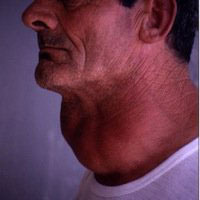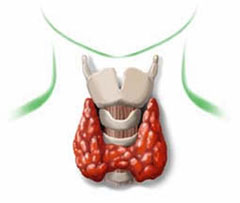Thyroid gland diseases (goiter) (Part one)

The thyroid is an endocrine gland located in the front part of the neck, below the "Adam's apple". It consists of two lobes (right and left) of equal size like two nuts that are connected at the bottom in the center by a bridge called the isthmus. At the back of it are placed 4 small glands, called the parathyroid glands, each the size of a grain of rice.
The pathology of the increase in the volume of the thyroid gland is called struma or goiter.
Thyroid gland diseases are the result of a disruption in the gland’s function in producing the hormones Triiodothyronine (T3) and Thyroxine (T4).
T3 is the active form of the hormone and constitutes 20% of the overall production of the thyroid.
T4 accounts for about 80% but can be converted into T3 according to the body's needs.
The hormones of the thyroid gland regulate many functions of metabolism, among which the development of the central nervous system, body growth, regulation of heart rhythm, etc.

To maintain a normal level of metabolism, it is necessary for the thyroid hormones to be secreted in precise amounts, otherwise serious consequences can occur in the human body even from small variations in the production of these hormones. The production of thyroid hormones is controlled by glands located in the brain: the pituitary and the hypothalamus. Thyrotropin (TSH) is a hormone produced by the pituitary gland, but this in turn is controlled by another hormone that is produced by the hypothalamus and that is the hormone TRH.
When a general enlargement of the gland occurs due to iodine deficiency, then the stimulation of TSH, which is a hormone produced by the pituitary gland (“Thyroid stimulating hormone”), happens.
The hormones of the thyroid gland have these actions:
- Increase the production of body temperature
- stimulate the metabolism of carbohydrates (sugars) and lipids (fats)
- stimulate the activity of the nervous system causing hypersensitivity
- favor the body growth of children.
The daily amount of iodine in the body is crucial for the production of these hormones. This amount varies from 20 to 1000 micrograms per day. In areas where there is a deficiency of iodine, there is a high incidence of pathologies of the gland which are referred to as areas with endemic goiter.
Endemic goiter is found in more than 10% of the population.
Sporadic goiter develops in non-endemic areas, but regardless of the areas, when an increase in the volume of the gland is observed, it is referred to as simple or non-toxic goiter.
In simple goiter, only an increase in the volume of the gland is noticed, without clinical signs and with normal metabolism. The diagnosis is verified with the euthyroid condition with normal concentrations of T3 and T4.
In areas where iodine deficiency is recognized, goiter may be accompanied by varying degrees of hypothyroidism.
In these areas where the population suffers from hypothyroid goiter, children born from these parents often suffer from poor mental and physical development, which in medicine is known as “cretinism”. If in these geographical areas, it would be made clear to the population that the factor of the development of goiter is the lack of iodine, adding this element to water or food through (iodized salt), would prevent this serious pathology for themselves and for their children.
The thyroid gland ensures a normal hormonal synthesis if it has the necessary amount of iodine. Iodine in the form of iodide is absorbed by the thyroid gland and by combining with the amino acid thyroxine, synthesizes the thyroid hormone.
The need for iodine is especially higher in pregnant women as well as in children. In adulthood, women are much more often affected by thyroid diseases than men. Throughout life, about 20% of women have the possibility to present problems with the thyroid gland.
This article was very impressive, especially for me who has been suffering from thyroid problems for 20 years and haven't done anything yet, only taking levothyroxine in the morning and nothing more
Sent by Luljeta Kola , më 10 October 2014 në 14:02
Please explain to us about: Thyroid papillary carcinoma
Sent by Aferdita, më 26 November 2014 në 18:18
There are no explanations for the prognosis of papillary thyroid cancer, especially for ages 20-30 years
Sent by Aferdita, më 27 November 2014 në 16:46
Hello, I am 50 years old. In July 2017, I underwent a thyroid ultrasound and was found to have cyst-covered thyroid nodules. My hormonal analysis showed the following results: Abti-TPO 898.8, whereas T.S.H was 1.84. For others like T3 and T4, there were no notable results. I am being treated with Mexanax and selenium. However, I do not feel any improvement. I experience shortness of breath, insomnia, headaches, and frequent throat tightness, but I have not lost weight. My next check-up is scheduled for November, and I don't know what to do
Sent by Beglie, më 11 September 2017 në 15:17
Dear Beglie,
We are not in Albania. Clinical consultation
I think should be done with the endocrinologist.
From what you say, I don't think it should be
Of much importance. The size and
The number of cysts should be taken into
consideration.
Viktori
Replay from Dr. Viktor QERESHNIKU, më 12 September 2017 në 02:56